A Guide to DSP Advertising Amazon
Unlock DSP Advertising Amazon. Learn to reach new audiences, boost sales, and maximize ROI with our guide on programmatic ads for brands and advertisers.
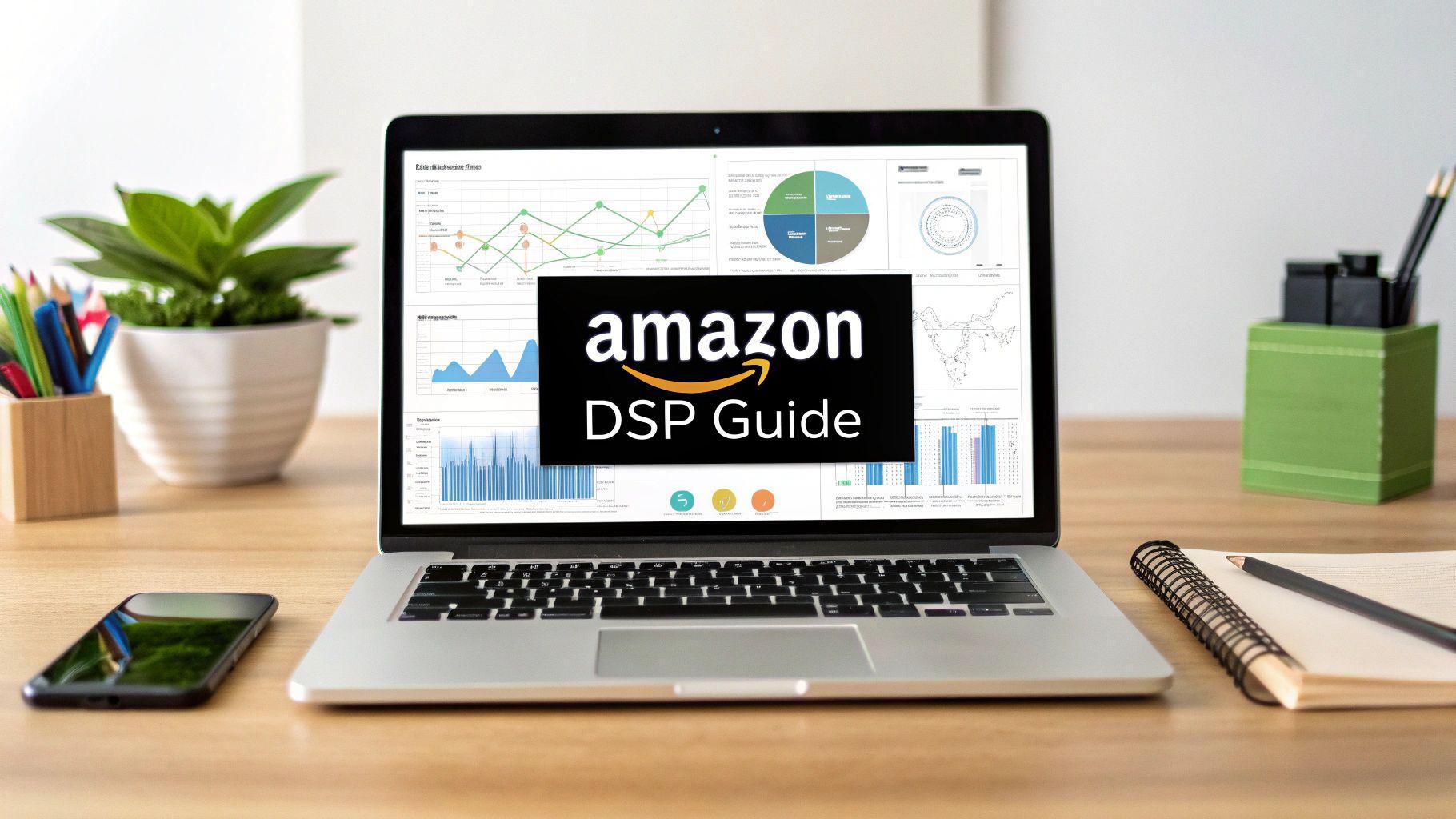
Amazon's Demand-Side Platform, or DSP, is a powerful tool that lets you buy display, video, and audio ads to connect with shoppers both on and off Amazon. It's a completely different beast from the standard Sponsored Ads you might be used to. Instead of just capturing existing demand, the DSP is all about proactively finding new customers across the web, using Amazon's incredible first-party shopper data to build your brand long before someone even thinks about making a purchase.
So, What's the Big Deal with Amazon DSP?
Think of it this way. If Amazon's Sponsored Ads are like setting up a shop in a bustling market to catch the eye of people already there to buy something, then the Amazon DSP is like putting up billboards on all the major highways leading into that town. It’s a proactive play to create demand, not just fulfill it.
While Sponsored Ads react to what users are actively searching for on Amazon, the DSP goes out and finds your perfect audience wherever they are online—reading the news, watching streams on Twitch, or just scrolling through their favorite apps.
This is the fundamental shift in thinking that makes the DSP so effective. It doesn't just wait for a customer to type "running shoes" into the search bar. It identifies someone who has browsed for running gear in the past, reads fitness blogs, and has shown other signs of an active lifestyle, and then puts your ad right in front of them. That's the core of what the Amazon Demand-Side Platform delivers.
Programmatic Reach Powered by Unbeatable Data
The "programmatic" part simply means the platform uses automated, real-time auctions to buy and place your ads. This happens in milliseconds, allowing you to reach a massive, highly relevant audience without the old-school hassle of manually negotiating with thousands of different websites and app owners.
The real magic of the Amazon DSP isn't just the automation; it's the data. It runs on exclusive, first-party insights into what millions of people actually search for, browse, and buy on Amazon. This lets you go way beyond basic demographics and target people based on real, tangible shopping behavior and intent.
This proactive strategy is clearly working. Amazon’s ad revenue is skyrocketing, and the DSP is a huge reason why. In a recent report, Amazon’s advertising services hit $17.3 billion in revenue, a 17% jump from the previous year, with much of that growth credited to the DSP's expansion. You can dive deeper into these spending trends and see how they are fueling the platform's growth with these insights from Digiday.
The image below gives you a clear visual breakdown of how DSP stacks up against standard display ads on some key metrics.
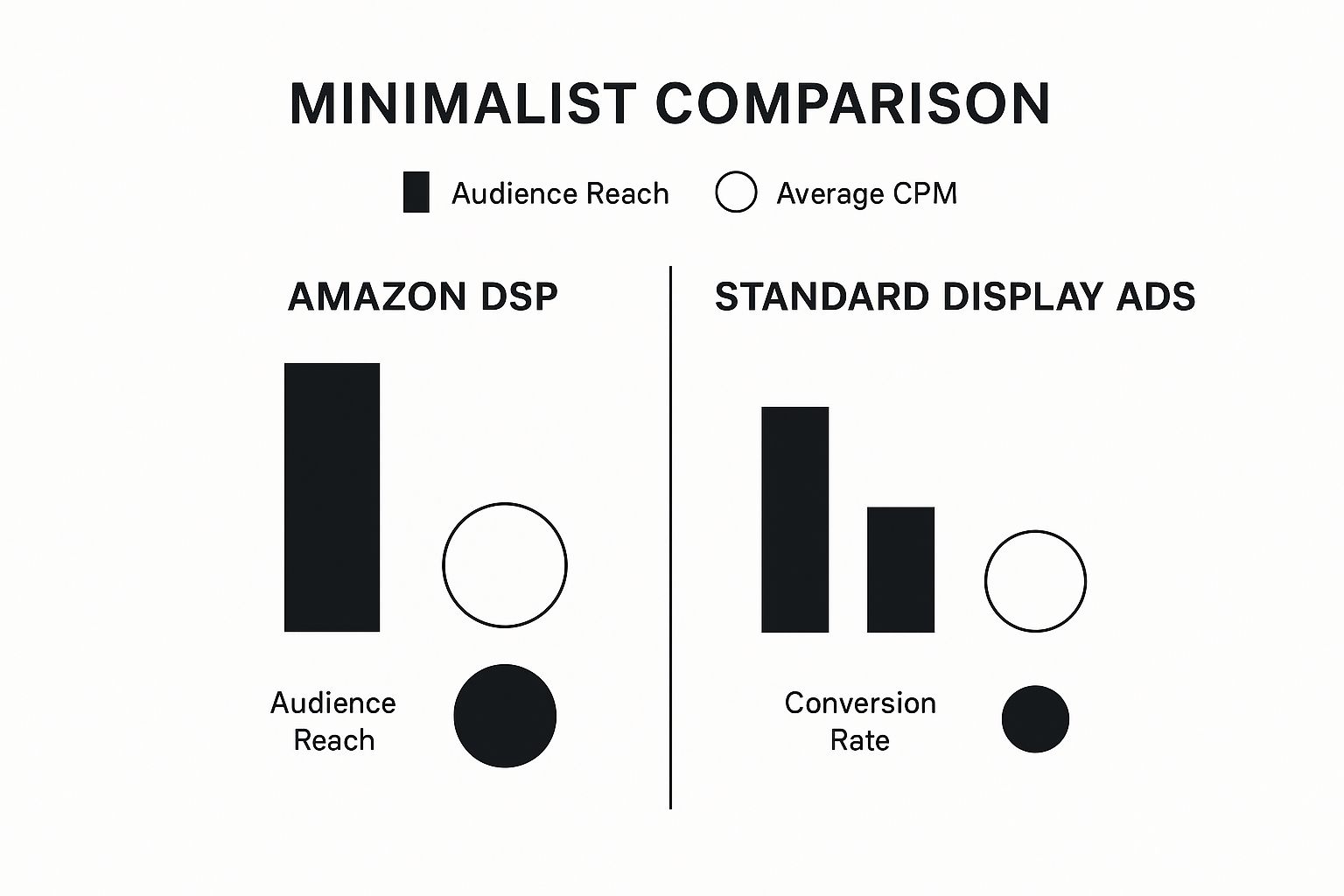
As you can see, while the upfront cost (CPM) for DSP might be higher, its laser-focused targeting often results in much better conversion rates and a far wider reach. It’s a strategic investment in building a complete marketing funnel that pays dividends in long-term growth.
Amazon DSP vs Amazon Sponsored Ads
To really understand where DSP fits, it helps to see it side-by-side with its more famous counterpart, Amazon Sponsored Ads (often just called Amazon PPC). They aren't competitors; they're teammates that play very different positions.
| Feature | Amazon DSP | Amazon Sponsored Ads (PPC) |
|---|---|---|
| Primary Goal | Create brand awareness and demand (Top/Mid-Funnel) | Capture existing demand and drive sales (Bottom-Funnel) |
| Where Ads Appear | On and off Amazon (websites, apps, devices) | Exclusively on Amazon's search results and product pages |
| Targeting Basis | Audiences (behavior, lifestyle, demographics, lookalikes) | Keywords and specific products (ASINs) |
| Cost Model | CPM (Cost Per Mille, or 1,000 impressions) | CPC (Cost Per Click) |
| Who It's For | Brands looking to grow reach beyond Amazon and build a long-term sales funnel. | Sellers focused on driving immediate sales from shoppers already on Amazon. |
| Control | Managed by Amazon or through approved agencies; requires higher budget. | Self-service platform available to all sellers and vendors. |
In short, you use Sponsored Ads to win the sale from someone who is already in the store and ready to buy. You use Amazon DSP to convince people to come to your store in the first place.
Getting to Grips with Powerful Audience Targeting Options
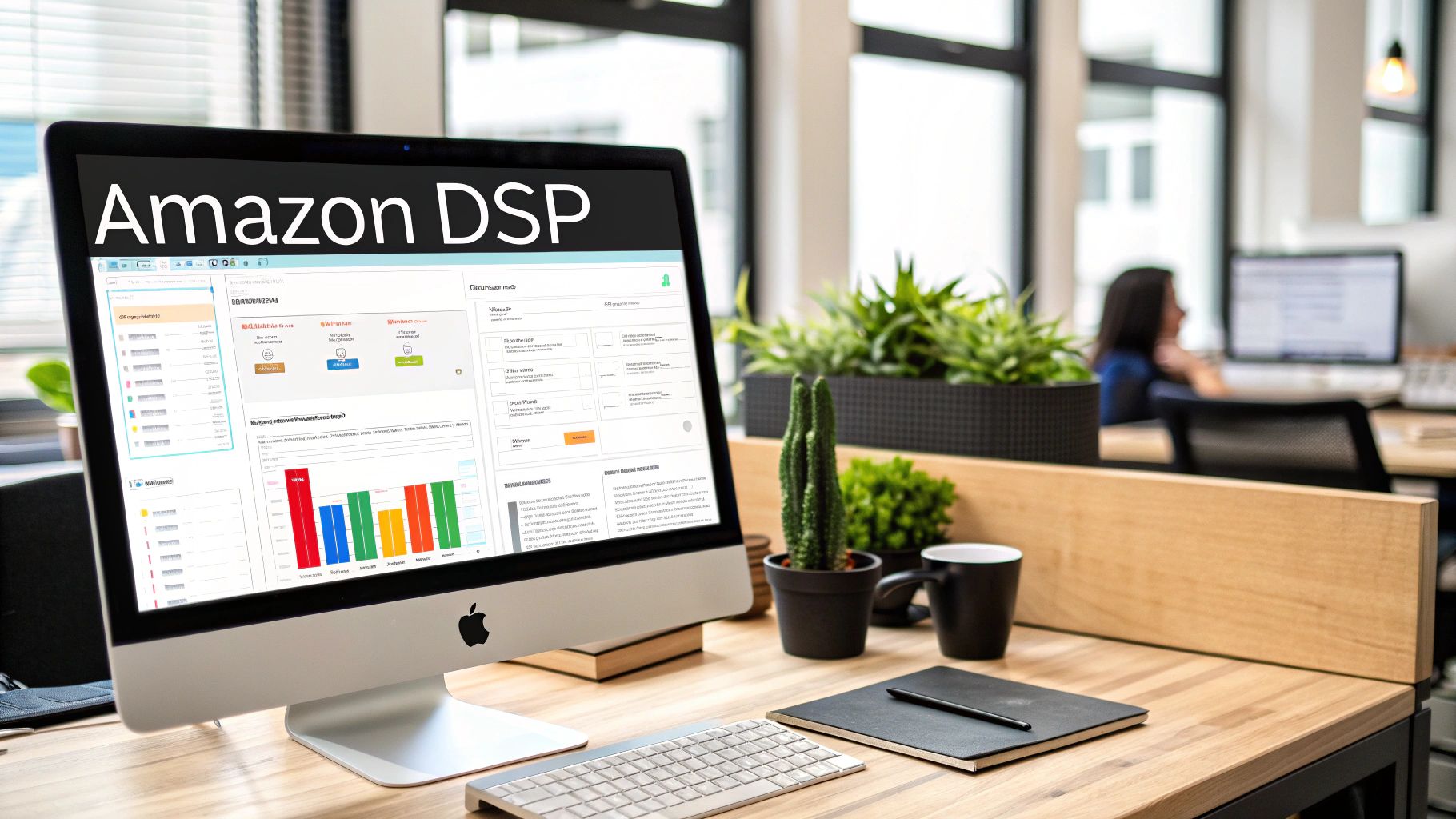
This is where the real magic of dsp advertising amazon happens. While Sponsored Ads are all about what people are searching for right now, the DSP is about who people are. It uses their long-term habits and recent shopping signals to paint a picture of the ideal customer. This lets you connect with the right person at the right time, whether they're on Amazon or browsing elsewhere online.
Think of it like fishing. Keyword targeting is like casting your line where you see fish jumping at the surface. Audience targeting, on the other hand, is like having a high-tech fish finder. It shows you exactly where the big schools of fish are, what kind they are, and even what they like to eat—helping you find success in parts of the lake you never even considered.
This incredible precision is all thanks to Amazon’s massive collection of first-party shopping data. We’re not just talking about basic demographics; we're talking about real, observable buying patterns. Let’s break down the main audience types you'll be working with.
Targeting Based on Interests and Habits
The first layer of DSP targeting is all about reaching people based on their general interests and current shopping mood. This is your starting point for building brand awareness and getting on the radar of broad, yet very relevant, groups of shoppers.
Amazon splits these into two main types:
Lifestyle Audiences: These are built from long-term interests and shopping behaviors over time. Think of them as broad "personality" profiles, perfect for top-of-funnel campaigns. For instance, a brand selling high-end kitchen gadgets could target the "Gourmet Cooking Enthusiasts" segment—people who consistently buy premium ingredients and browse for new kitchenware.
In-Market Audiences: These are much more immediate and action-oriented. An in-market audience is a group of people who are actively shopping for a specific type of product right now. A company selling running shoes could target the "Athletic Footwear" in-market audience, which is full of people who’ve searched for or viewed running shoes in the last 30 days.
You can get really clever by combining these. Use a Lifestyle audience to introduce your brand to general fitness lovers, then follow up with an In-Market audience to show specific product ads to those ready to buy new gear.
Reaching Shoppers Again with Custom Audiences
Finding new customers is great, but getting people who’ve already shown interest to come back is one of the smartest moves you can make. This is where the Amazon DSP really shines, letting you re-engage potential customers and bring them back to finish what they started. This is often called retargeting or remarketing.
You can build custom audiences from all sorts of specific interactions with your brand, both on and off Amazon. This lets you craft super-relevant ads that speak directly to what a user has already done.
Here are a few of the most powerful ways to do it:
- Pixel-Based Retargeting: Drop the Amazon pixel on your own website, and you can build an audience of everyone who visited. You can then serve them ads as they browse other sites and apps.
- Product Viewers: This is a classic. Target shoppers who clicked on your product detail pages on Amazon but didn't buy. They were interested enough to look, so a little reminder can go a long way.
- Cart Abandoners: This is gold. Create an audience of people who added your product to their cart but got distracted before checking out. These are hot leads!
For example, a home goods brand could retarget someone who viewed a specific set of decorative pillows with an ad showing those exact pillows. It’s a simple, effective way to rescue a sale that was almost lost.
Finding New Customers with Lookalike Audiences
Once you know who your best customers are, what's next? Find more people just like them. That's exactly what Lookalike Audiences are for. This feature is a game-changer.
You give the DSP a "seed" audience—like a list of your past purchasers or most loyal customers. The DSP then analyzes their behavior and scours its massive network to find new people who act and shop in very similar ways. It’s essentially cloning your ideal customer profile to find a whole new group of people who are likely to be interested in your brand.
You can create a lookalike from a few different sources:
- An audience of your past buyers.
- People who have visited your product detail page.
- Your own customer list, which you can upload (it's hashed for privacy).
Imagine a sports nutrition brand. They could create a lookalike audience from customers who repeatedly buy their protein powder. The DSP would then go find a new audience of shoppers who also frequent gym-related categories and buy other fitness supplements, serving them ads for the brand. This is how you scale your business and find sustainable growth with DSP advertising on Amazon.
Mastering Creative Formats and Ad Placements
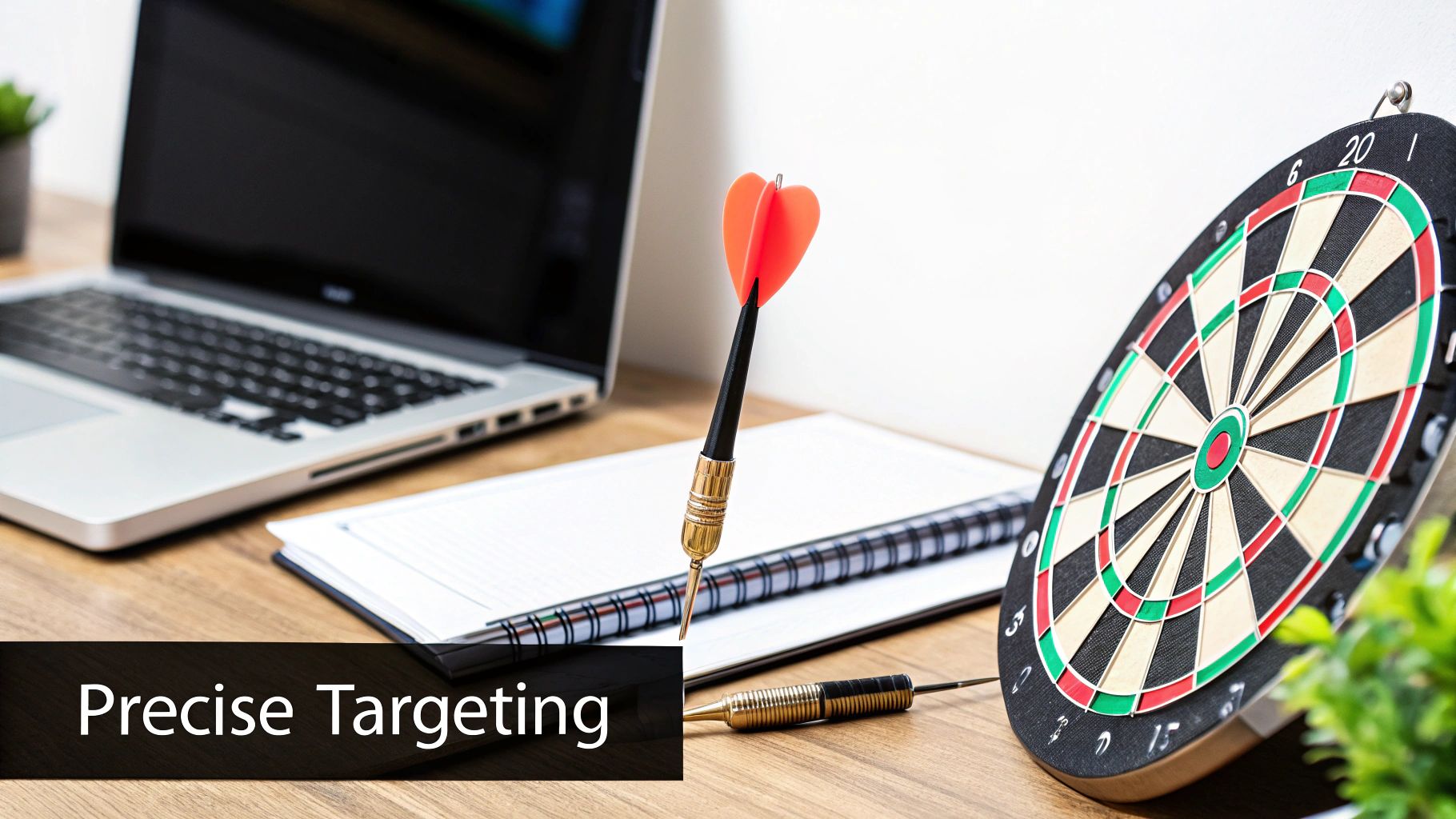
Alright, so you've nailed down who you want to reach. The next big question is: what are you going to show them, and where will they see it? This is where your Amazon DSP advertising strategy really comes to life. We're moving way beyond simple banner ads here. The DSP gives you a whole toolkit of creative options designed to grab attention and get people to act, no matter where they are in their buying journey.
Think of it like this: your creative is the message, and the ad placement is the delivery route. A brilliant message sent to the wrong address is a waste. And a weak message sent to the perfect spot will just fall flat. The magic happens when you line up the right creative with the right placement to truly connect with your audience.
Exploring Key Creative Formats
The Amazon DSP offers a few core ad formats, and each one has its own strengths. The right choice really hinges on what you're trying to achieve—are you building brand awareness, getting people to consider your product, or pushing for that final sale?
Here are the main creative types you'll be working with:
Display Ads: These are the visual workhorses of the programmatic world. They can be static images with a strong call-to-action or even animated GIFs to catch the eye. They're incredibly versatile and perfect for building brand recognition or retargeting shoppers who've already shown interest.
Video Ads: Nothing tells a story and builds a connection like video. With the DSP, you can run in-stream ads (before, during, or after video content) and out-stream ads (popping up in non-video spots, like an article). This format is fantastic for showing off your product and creating a more emotional hook.
Dynamic eCommerce Ads: This is where the platform's smarts really come into play. These ads automatically pull information like images, titles, and prices straight from your Amazon product detail pages. They can even feature products a specific user has already looked at, making them a powerhouse for retargeting and closing the deal.
The key thing to remember is that great creative isn't just about good design; it’s about context. An ad showing the exact pair of shoes a shopper browsed yesterday is infinitely more powerful than a generic brand banner. This level of personalization is a huge advantage of the DSP.
Where Your Ads Can Appear
One of the biggest myths about Amazon DSP advertising is that your ads only show up on Amazon.com. Not true. The platform actually gives you access to a massive network of websites and apps, so you can reach your audience wherever they hang out online.
Getting your placement right is more critical than ever. Amazon's ad business is expected to hit nearly $94 billion in global revenue by 2025, which means competition is fierce. And since 75% of shoppers never go past the first page of results, getting that prime real estate is key to being seen. You can dig deeper into this with a guide to maximizing visibility and sales on Algofy.com.
Your ads can run across three main areas:
Amazon-Owned and Operated Properties: This is more than just Amazon.com. It also includes other popular sites Amazon owns, like IMDb for movie buffs or Twitch for the huge gaming community. Placing ads here lets you tap into very specific, engaged audiences.
Amazon Publisher Direct: This network connects you to top-tier inventory on third-party publisher websites and apps. Amazon has direct relationships with these publishers, so you know your ads are showing up in high-quality, brand-safe places.
Third-Party Exchanges: For the widest possible reach, the DSP plugs into major ad exchanges. This opens the door to millions of other websites and apps across the internet, helping you find niche audiences wherever they might be.
Imagine you're selling outdoor gear. You could run a video ad on Twitch to catch adventure-loving gamers, place a display ad on a popular weather app through a third-party exchange, and then retarget interested shoppers with dynamic ads back on Amazon.com. This kind of multi-channel approach keeps you top-of-mind throughout a customer's entire digital day.
Alright, let's talk money. You've figured out who you want to reach and what ads to show them. Now, how do you actually pay for it and make sure you're not overspending?
This is where bidding comes in. Think of it as a super-fast, automated auction. Every time someone opens a website or an app with an ad slot, an auction happens in milliseconds. Your bidding strategy is what tells Amazon how much you’re willing to pay to win that ad space and show your ad.
The main currency here is CPM, which stands for Cost Per Thousand Impressions. This is a big shift if you're used to Sponsored Ads where you pay per click (CPC). With DSP, you pay every time your ad is shown 1,000 times. This is perfect for building brand awareness, where the goal is simply getting your name and message in front of the right eyeballs.
The Amazon DSP dashboard gives you a clean, central hub to manage all of this without getting overwhelmed.
Everything you need to control your spending and see how things are going is laid out right there, which helps you make smart decisions on the fly.
Choosing the Right Bidding Strategy
Your bidding strategy is your game plan for those auctions. It's how you tell the DSP to spend your money to achieve your goals. Amazon gives you a couple of ways to do this, and picking the right one is crucial for getting the most bang for your buck.
Let's break them down:
- Maximize Performance: This is the "smart" autopilot option. You tell Amazon your main objective—maybe it's reaching as many people as possible or getting the most clicks—and its algorithm takes over. It adjusts your bids in real-time to squeeze the best results out of your budget. For most advertisers, this is the best place to start.
- Set a Fixed Bid: This puts you in the driver's seat. You decide the exact CPM you want to pay for every auction. While you get more control, it's also riskier. Bid too low, and you'll miss out on showing your ad. Bid too high, and you'll just be burning through your budget unnecessarily.
My advice? Start with 'Maximize Performance'. Amazon's system sees millions of data points a human never could. It's built to find that perfect balance between winning the bid and not overpaying. Let the machine do the heavy lifting first.
How to Manage Your Campaign Budget
Good budget management is what makes or breaks a DSP campaign. You don’t want to blow your entire budget in the first week and then go dark. Amazon DSP gives you some simple, powerful controls to keep your spending paced and predictable.
You have two main levers to pull:
- Campaign-Level Budget: This is your total, hard-stop budget for the entire campaign. Once it's spent, the campaign turns off. It's perfect for things like a holiday promotion where you have a fixed amount of money to work with.
- Daily Budget: This sets a cap on how much you can spend each day. It’s essential for pacing. It ensures your ads run consistently from the first day of the campaign to the last, rather than spending it all upfront.
A smart way to work is by using both. For example, if you have a $10,000 budget for a month-long campaign, you could set a daily cap of around $333. This combination gives you steady, consistent exposure and prevents any one day from eating up your funds.
When you pair a smart bidding strategy with careful budget pacing, you get a campaign that delivers results without any nasty surprises on your invoice.
How to Measure Success and Optimize Your ROI
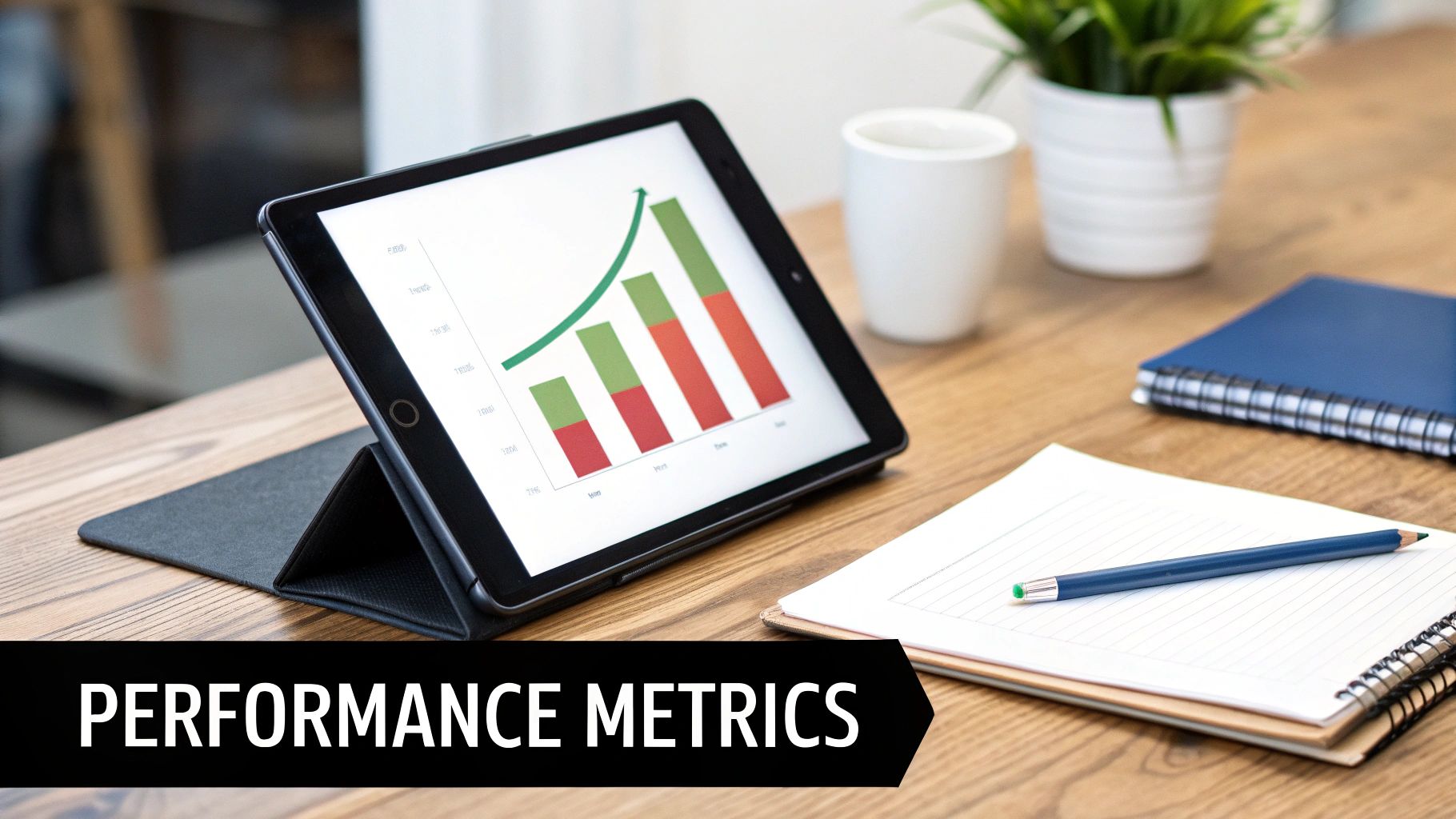
Getting a campaign for dsp advertising on Amazon up and running is just the start. The real work begins when you have to prove it actually worked. Success isn't about vanity metrics like impressions or clicks; to truly understand your return on investment (ROI), you have to look at the metrics that show how your ads are actually changing shopper behavior and driving growth.
Think of it like coaching a basketball team. The number of passes (impressions) is nice, but what you really care about are the shots on goal (detail page views) and, of course, the points on the board (purchases). The Amazon DSP gives you a front-row seat to this entire game, letting you track the customer's journey from their first glance at your ad all the way to the final sale. This is how you make smart, data-backed decisions that turn a good campaign into a great one.
Moving Beyond Surface-Level Metrics
To really see the impact of your DSP campaigns, you need to focus on metrics that show genuine customer engagement and a real desire to buy. These KPIs tell you the story of how well your ads are guiding people from curious onlookers to loyal customers.
Here are the core metrics you should have your eyes on:
Detail Page View Rate (DPVR): This is the percentage of people who saw your ad and were interested enough to click through to your product page. A high DPVR is a fantastic sign that your creative and targeting are hitting the mark.
Add to Cart (ATC) Rate: This one’s a big deal. It tracks how many people added your product to their cart after seeing your ad. It’s a powerful indicator of serious buying intent.
Purchase Rate: This is the ultimate bottom-line metric. It’s the percentage of people who saw your ad and actually bought your product. This is your "points on the board" and a direct measure of how well your campaign is converting.
Finding New Growth with New-to-Brand Metrics
One of the most valuable things about Amazon DSP is its ability to show you how many new customers you're winning over. That’s where New-to-Brand (NTB) metrics come into play. These metrics isolate sales from shoppers who haven't bought anything from your brand on Amazon in the last 12 months.
New-to-Brand metrics are your clearest signal of real, sustainable growth. They prove your DSP campaigns are doing more than just reminding your existing customers to buy again—they're actively expanding your audience and building your brand's future.
This focus on acquiring new customers is a huge part of what makes Amazon's advertising platform so dominant. The scale is massive, with projections showing Amazon's retail media ad revenue is set to soar past $60 billion in 2025. This growth underscores just how critical it is for brands to use tools like the DSP to find new pockets of customers. You can check out more forecasts on Amazon's impressive ad revenue from Advanced Television.
A Practical Guide to Continuous Optimization
Data is useless if you don't act on it. Think of your reports as a roadmap for improvement. Here’s how you can take what you’ve learned and use it to constantly boost your Return on Ad Spend (ROAS).
1. A/B Test Your Ad Creatives Never just guess what will perform best. You need to be testing all the time.
- Test one thing at a time: Change the headline, the image, or the call-to-action, but never all at once. This is the only way to know for sure what's making a difference.
- Give it enough time: Let your tests run long enough to get solid, statistically significant data before you crown a winner.
2. Refine Your Audience Targeting Your campaign reports will tell you exactly which audiences are responding and which aren't.
- Analyze by segment: Dig into your reports to see which audiences (like Lifestyle, In-Market, or Lookalike) are giving you the best DPVR and purchase rates.
- Follow the money: Shift your budget toward your top-performing audiences and hit pause on the ones that just aren't converting.
3. Adjust Your Bidding Strategy Your bids have a direct impact on your campaign's reach and how much you're paying for it.
- Watch your CPM: If your Cost Per Thousand Impressions (CPM) is sky-high for an audience that isn't performing well, it’s probably time to lower your bid or cut that segment loose.
- Let the algorithm help: For most campaigns, using Amazon's "Maximize Performance" bidding option is a smart move. It lets the system optimize bids for you, finding the most efficient way to hit your goals.
By combining a solid grasp of these key metrics with a commitment to constantly testing and tweaking, you can turn your dsp advertising Amazon spend into a powerful, predictable engine for business growth.
Amazon DSP: Your Questions Answered
Even after getting the rundown on what Amazon DSP can do, it's natural to have some practical questions. It's a big, powerful platform, and knowing the nitty-gritty details is what separates a successful campaign from a wasted budget. Let's tackle some of the most common questions we hear from brands considering the DSP.
We'll break down who this platform is really for, what it costs to get in the game, and how it all fits together to build a complete marketing strategy.
Who Should Use Amazon DSP?
So, is the Amazon DSP right for you? In our experience, it’s a perfect fit for two main types of advertisers.
First, it’s for established brands looking to grow beyond the digital walls of Amazon. If you're ready to build serious brand awareness and reel in new customers from all corners of the web, the DSP is your megaphone.
Second, it’s a fantastic next step for advertisers who feel like they’ve squeezed every last drop of performance out of their Amazon Sponsored Ads. When you've hit a plateau and need a new engine for growth, the DSP’s ability to proactively find customers is exactly what you need.
At its core, the DSP is for anyone whose strategy involves finding new shoppers before they even start searching, bringing back interested window-shoppers, or driving traffic from outside sites directly to their Amazon listings. It works wonders for brands selling on Amazon, but even those that don't can use it, though sellers on the platform get access to more of the juicy, conversion-focused tools.
What Is the Minimum Budget for Amazon DSP?
This is the big one: "How much is this going to cost?" The answer really depends on how you plan to run it. You have two main options, and they come with very different price tags.
- Managed-Service: This is where you let Amazon's own team run your campaigns for you. It's a white-glove service, but it requires a serious investment, typically starting at $50,000 USD. This route is really meant for large-scale brands that want expert management without the overhead of an in-house team.
- Self-Service: This is the more common route for agencies and brands who want to get their hands dirty. While there isn't an official "minimum spend," you need to be realistic. To give the algorithms enough data to learn and optimize, you should plan on spending at least a few thousand dollars a month. Anything less, and you’re just flying blind.
For smaller sellers, our advice is always the same: master your Sponsored Ads first. Maximize your performance on Amazon itself, build a solid foundation, and then scale up to the DSP. It’s a much smarter and more financially sound way to grow.
How Does Amazon DSP Support Full-Funnel Advertising?
This is where the Amazon DSP truly shines. It isn't just a tool for one specific job; it’s a complete system for guiding a customer from "Who are you?" all the way to "Take my money!"
Think of it as a connected journey. Here’s how it works at each stage of the funnel:
Awareness (Top of Funnel): Your goal here is to get on people's radar. With the DSP, you can run eye-catching video and display ads targeting broad Lifestyle audiences. Imagine reaching "fitness enthusiasts" or "home chefs" with your brand's message on their favorite blogs or news sites, long before they're actively shopping.
Consideration (Middle of Funnel): Okay, they've seen you. Now you need to keep their interest. This is where you can retarget shoppers who clicked on your product page but didn't buy. A well-placed display ad reminding them of your product’s key benefits or a compelling video can be just the nudge they need to take you seriously.
Conversion (Bottom of Funnel): Time to close the sale. The DSP lets you target high-intent shoppers with pinpoint accuracy, like those who added your product to their cart but never checked out. Even better, you can use Lookalike audiences to find brand-new customers who act just like your best buyers, giving you a direct line to people who are most likely to convert.
By tying these stages together, Amazon's DSP lets you create a seamless path for your customers. You can meet them on an external website and guide them all the way to a purchase on Amazon, all while tracking every touchpoint to see what’s working.
Ready to move beyond guesswork and unlock the full potential of your Amazon advertising? Headline Marketing Agency specializes in data-driven PPC and DSP strategies that deliver real, profitable growth. We go beyond surface-level metrics to build long-term brand equity and marketplace dominance. Schedule your free brand audit with us today and discover what a true, analytics-focused partnership can do for your business.
Ready to Transform Your Amazon PPC Performance?
Get a comprehensive audit of your Amazon PPC campaigns and discover untapped growth opportunities.